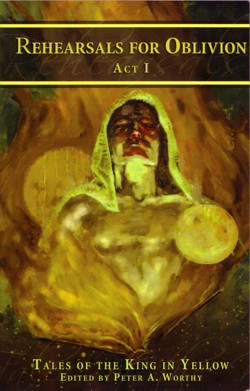Rehearsals for Oblivion
edited by Peter Worthy
Originally for the Samhain, 2006 mailing of the Esoteric Order of Dagon (#136)

There are certain books that one simply should not read while one has a fever. Although I did not have any nightmares after starting Rehearsals for Oblivion, I did have nebulous fever dreams of amorphous, flowing strangeness that in some way connected with the book. So I consider it to have started off very well.
Rehearsals for Oblvivion is an Elder Signs Press book, under their Dimensions imprint. The editor is Peter Worthy, whose name I have seen in at least one previous book of Mythos stories. The book consists of 246 pages of stories and poetry, the cover is fairly thin cardstock, and the price is a reasonable $17.95. King in Yellow-related stories often have a very different tone that Lovecraft pastiches. These stories tend to be more decadent, and when dreams are involved, they are more nebulous and less structured than Lovecraft's dream tales. What is particularly interesting about this collection is that there are several repeated themes, such as automatons, that do not stem from Chambers or Bierce.
This book won me over right away by reprinting two of John Tynes's three stories having to do with the King in Yellow. "Ambrose" is the story of a man with no past who lives in the ever-shifting city of Carcossa. It is an extraordinarily well-written story, and very effectively conveys a dream-like atmosphere in Carcossa. "Broadalbin", later in the collection is a bit less esoteric, dealing with concretely in the real world with a very William Burroughs-esque bank-robber/writer/junkie as a main character. I'm a sucker for a well-developed character with backstory, and "Broadalbin" has it in spades. I loved the story when it first came out, and I'm even more impressed with it ten years later.
Michael Minnis, whose "A Little Colour in You Cheeks" was one of the real stand-outs of Horrors Beyond rather boldly contributes a tale of Nazi soldiers who have become separated from their division during the retreat from Russian forces. "Chartruse" once again demonstrates Minnis's ability to provide a very immersive tale, with authentic-feeling details and complex, well-realized characters.
Also of particular interest is Carlos Orsi Matrinho's "The Machine in Yellow", a story that takes place in Brazil, and shows some of the tropes that seem to have worked their way into King in Yellow stories–automatons, for example. It works very well, especially with its milieu outside the usual American or British setting.
These are the highlights of the collection. Other stories, such as J. Warlock Vance's "The Adventure of the Yellow Sign" are less successful. Vance's idea to mix the King in Yellow with Sherlock Holmes is not the worst story in the collection, but striking a balance between the decadent atmosphere of a Robert W. Chambers pastiche with the very down-to-Earth Sherlock Holmes is a very difficult proposition, and I don't believe Vance found the precise balance that would have allowed him to carry the story off. It's not a bad story, but it doesn't gleam with a stunning inner malevolence the way that some of the stories in this collection do.
On the whole, I am quite impressed with the consistent quality of the stories in this collection. The vast array of settings and approaches to Robert W. Chambers' keep the repetition of certain story elements from becoming stale, and that's quite the achievement.